The Husky Energy Company
VerifiedAdded on 2022/10/11
|12
|2384
|40
AI Summary
Contribute Materials
Your contribution can guide someone’s learning journey. Share your
documents today.
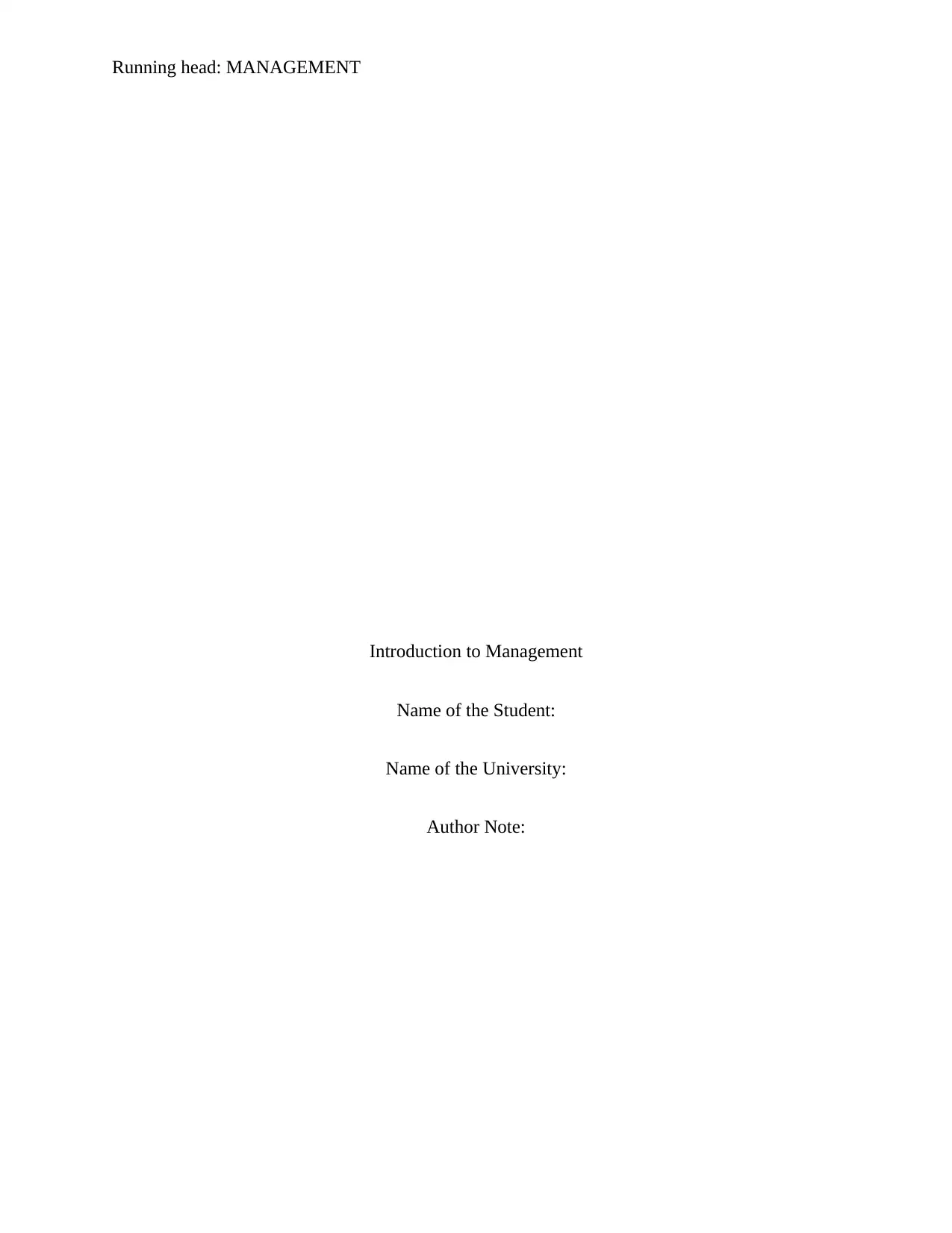
Running head: MANAGEMENT
Introduction to Management
Name of the Student:
Name of the University:
Author Note:
Introduction to Management
Name of the Student:
Name of the University:
Author Note:
Secure Best Marks with AI Grader
Need help grading? Try our AI Grader for instant feedback on your assignments.
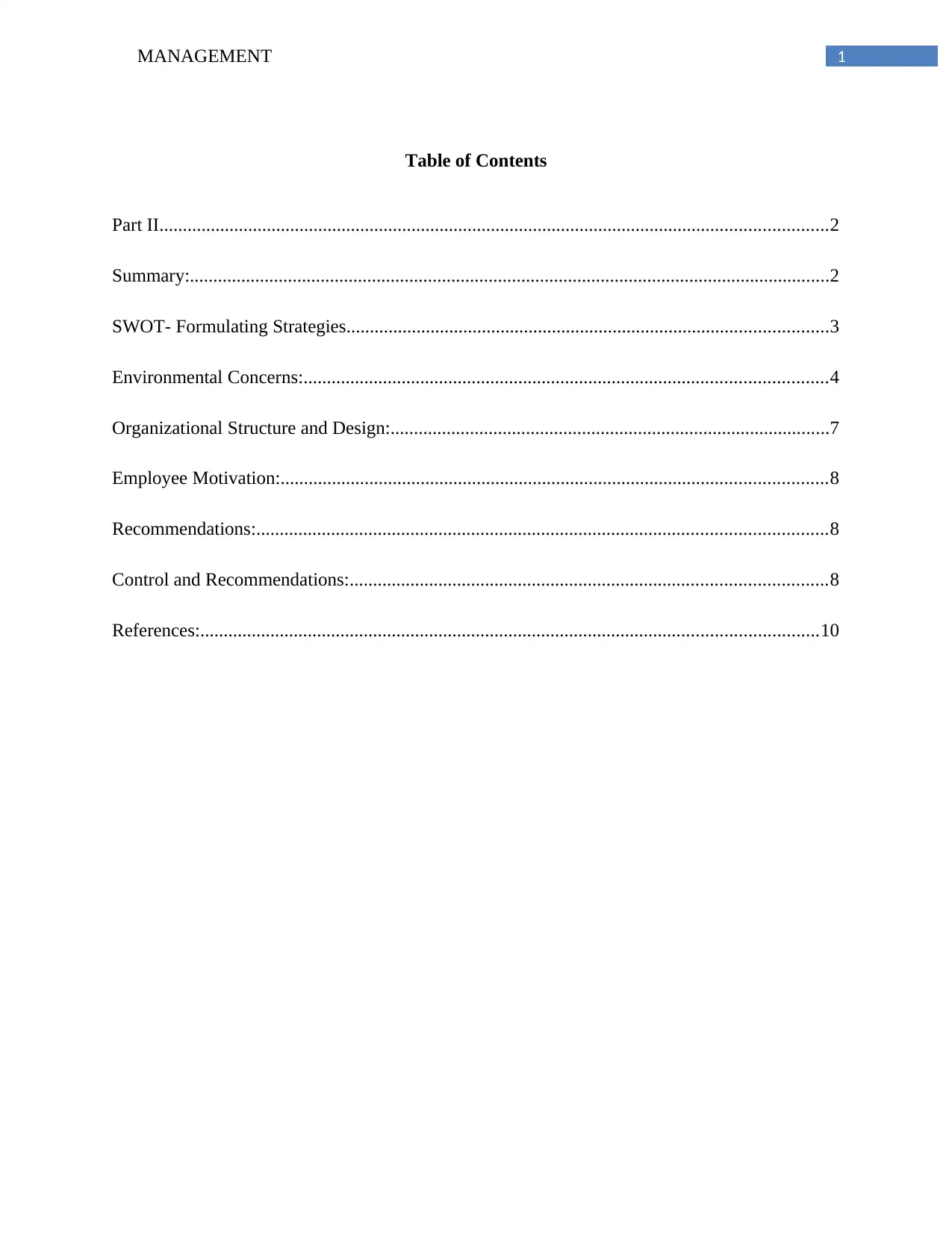
1MANAGEMENT
Table of Contents
Part II...............................................................................................................................................2
Summary:.........................................................................................................................................2
SWOT- Formulating Strategies.......................................................................................................3
Environmental Concerns:................................................................................................................4
Organizational Structure and Design:..............................................................................................7
Employee Motivation:.....................................................................................................................8
Recommendations:..........................................................................................................................8
Control and Recommendations:......................................................................................................8
References:....................................................................................................................................10
Table of Contents
Part II...............................................................................................................................................2
Summary:.........................................................................................................................................2
SWOT- Formulating Strategies.......................................................................................................3
Environmental Concerns:................................................................................................................4
Organizational Structure and Design:..............................................................................................7
Employee Motivation:.....................................................................................................................8
Recommendations:..........................................................................................................................8
Control and Recommendations:......................................................................................................8
References:....................................................................................................................................10
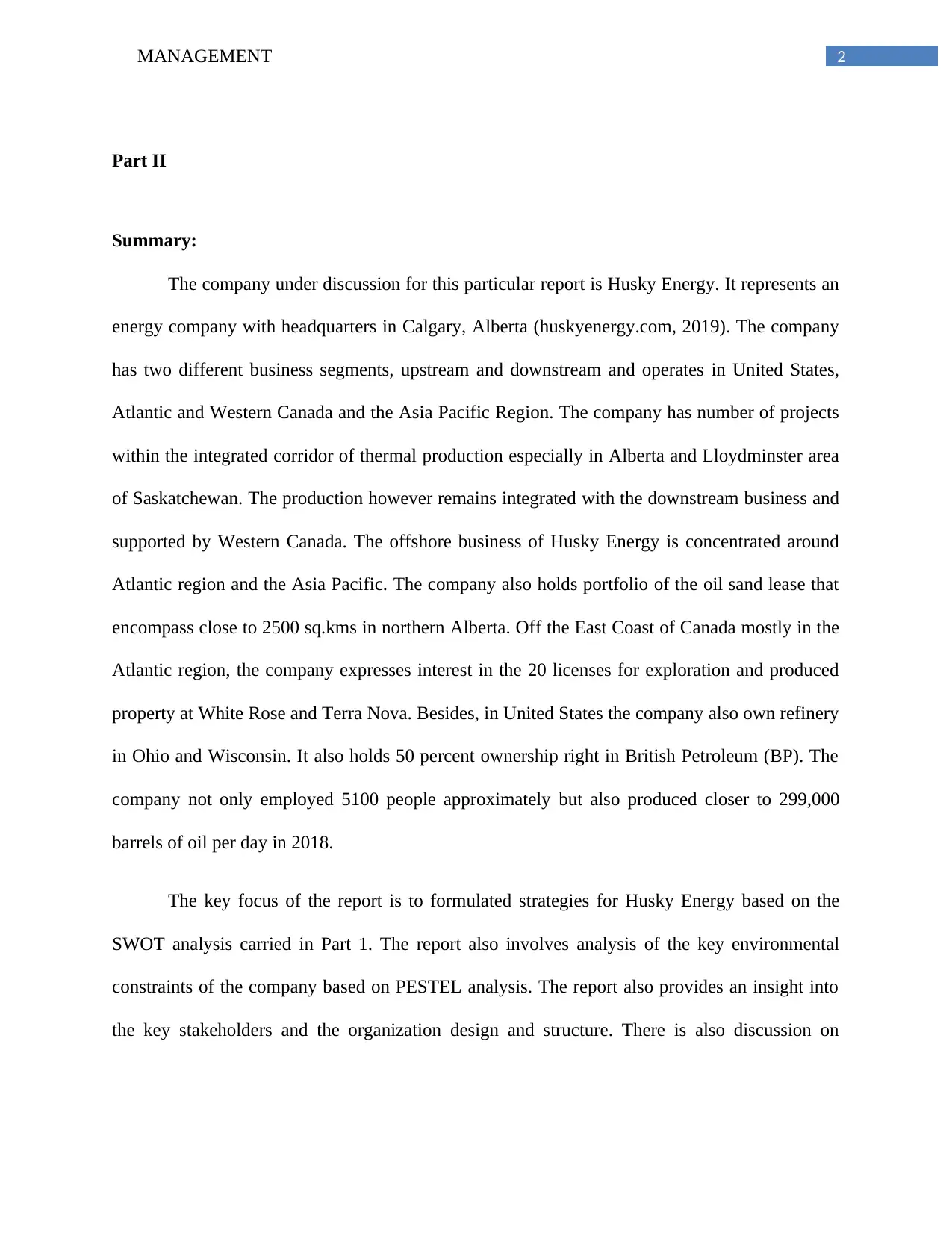
2MANAGEMENT
Part II
Summary:
The company under discussion for this particular report is Husky Energy. It represents an
energy company with headquarters in Calgary, Alberta (huskyenergy.com, 2019). The company
has two different business segments, upstream and downstream and operates in United States,
Atlantic and Western Canada and the Asia Pacific Region. The company has number of projects
within the integrated corridor of thermal production especially in Alberta and Lloydminster area
of Saskatchewan. The production however remains integrated with the downstream business and
supported by Western Canada. The offshore business of Husky Energy is concentrated around
Atlantic region and the Asia Pacific. The company also holds portfolio of the oil sand lease that
encompass close to 2500 sq.kms in northern Alberta. Off the East Coast of Canada mostly in the
Atlantic region, the company expresses interest in the 20 licenses for exploration and produced
property at White Rose and Terra Nova. Besides, in United States the company also own refinery
in Ohio and Wisconsin. It also holds 50 percent ownership right in British Petroleum (BP). The
company not only employed 5100 people approximately but also produced closer to 299,000
barrels of oil per day in 2018.
The key focus of the report is to formulated strategies for Husky Energy based on the
SWOT analysis carried in Part 1. The report also involves analysis of the key environmental
constraints of the company based on PESTEL analysis. The report also provides an insight into
the key stakeholders and the organization design and structure. There is also discussion on
Part II
Summary:
The company under discussion for this particular report is Husky Energy. It represents an
energy company with headquarters in Calgary, Alberta (huskyenergy.com, 2019). The company
has two different business segments, upstream and downstream and operates in United States,
Atlantic and Western Canada and the Asia Pacific Region. The company has number of projects
within the integrated corridor of thermal production especially in Alberta and Lloydminster area
of Saskatchewan. The production however remains integrated with the downstream business and
supported by Western Canada. The offshore business of Husky Energy is concentrated around
Atlantic region and the Asia Pacific. The company also holds portfolio of the oil sand lease that
encompass close to 2500 sq.kms in northern Alberta. Off the East Coast of Canada mostly in the
Atlantic region, the company expresses interest in the 20 licenses for exploration and produced
property at White Rose and Terra Nova. Besides, in United States the company also own refinery
in Ohio and Wisconsin. It also holds 50 percent ownership right in British Petroleum (BP). The
company not only employed 5100 people approximately but also produced closer to 299,000
barrels of oil per day in 2018.
The key focus of the report is to formulated strategies for Husky Energy based on the
SWOT analysis carried in Part 1. The report also involves analysis of the key environmental
constraints of the company based on PESTEL analysis. The report also provides an insight into
the key stakeholders and the organization design and structure. There is also discussion on
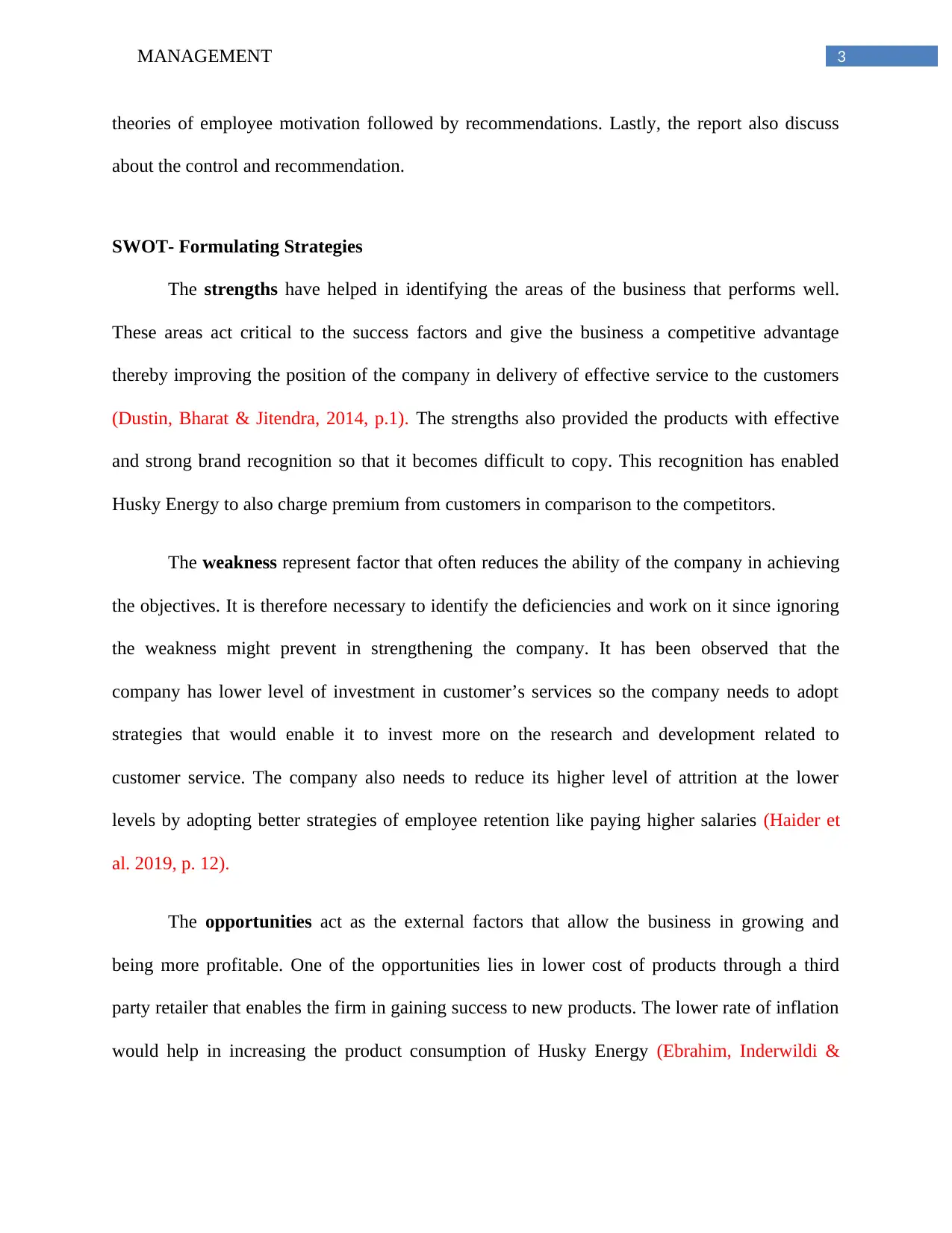
3MANAGEMENT
theories of employee motivation followed by recommendations. Lastly, the report also discuss
about the control and recommendation.
SWOT- Formulating Strategies
The strengths have helped in identifying the areas of the business that performs well.
These areas act critical to the success factors and give the business a competitive advantage
thereby improving the position of the company in delivery of effective service to the customers
(Dustin, Bharat & Jitendra, 2014, p.1). The strengths also provided the products with effective
and strong brand recognition so that it becomes difficult to copy. This recognition has enabled
Husky Energy to also charge premium from customers in comparison to the competitors.
The weakness represent factor that often reduces the ability of the company in achieving
the objectives. It is therefore necessary to identify the deficiencies and work on it since ignoring
the weakness might prevent in strengthening the company. It has been observed that the
company has lower level of investment in customer’s services so the company needs to adopt
strategies that would enable it to invest more on the research and development related to
customer service. The company also needs to reduce its higher level of attrition at the lower
levels by adopting better strategies of employee retention like paying higher salaries (Haider et
al. 2019, p. 12).
The opportunities act as the external factors that allow the business in growing and
being more profitable. One of the opportunities lies in lower cost of products through a third
party retailer that enables the firm in gaining success to new products. The lower rate of inflation
would help in increasing the product consumption of Husky Energy (Ebrahim, Inderwildi &
theories of employee motivation followed by recommendations. Lastly, the report also discuss
about the control and recommendation.
SWOT- Formulating Strategies
The strengths have helped in identifying the areas of the business that performs well.
These areas act critical to the success factors and give the business a competitive advantage
thereby improving the position of the company in delivery of effective service to the customers
(Dustin, Bharat & Jitendra, 2014, p.1). The strengths also provided the products with effective
and strong brand recognition so that it becomes difficult to copy. This recognition has enabled
Husky Energy to also charge premium from customers in comparison to the competitors.
The weakness represent factor that often reduces the ability of the company in achieving
the objectives. It is therefore necessary to identify the deficiencies and work on it since ignoring
the weakness might prevent in strengthening the company. It has been observed that the
company has lower level of investment in customer’s services so the company needs to adopt
strategies that would enable it to invest more on the research and development related to
customer service. The company also needs to reduce its higher level of attrition at the lower
levels by adopting better strategies of employee retention like paying higher salaries (Haider et
al. 2019, p. 12).
The opportunities act as the external factors that allow the business in growing and
being more profitable. One of the opportunities lies in lower cost of products through a third
party retailer that enables the firm in gaining success to new products. The lower rate of inflation
would help in increasing the product consumption of Husky Energy (Ebrahim, Inderwildi &
Secure Best Marks with AI Grader
Need help grading? Try our AI Grader for instant feedback on your assignments.
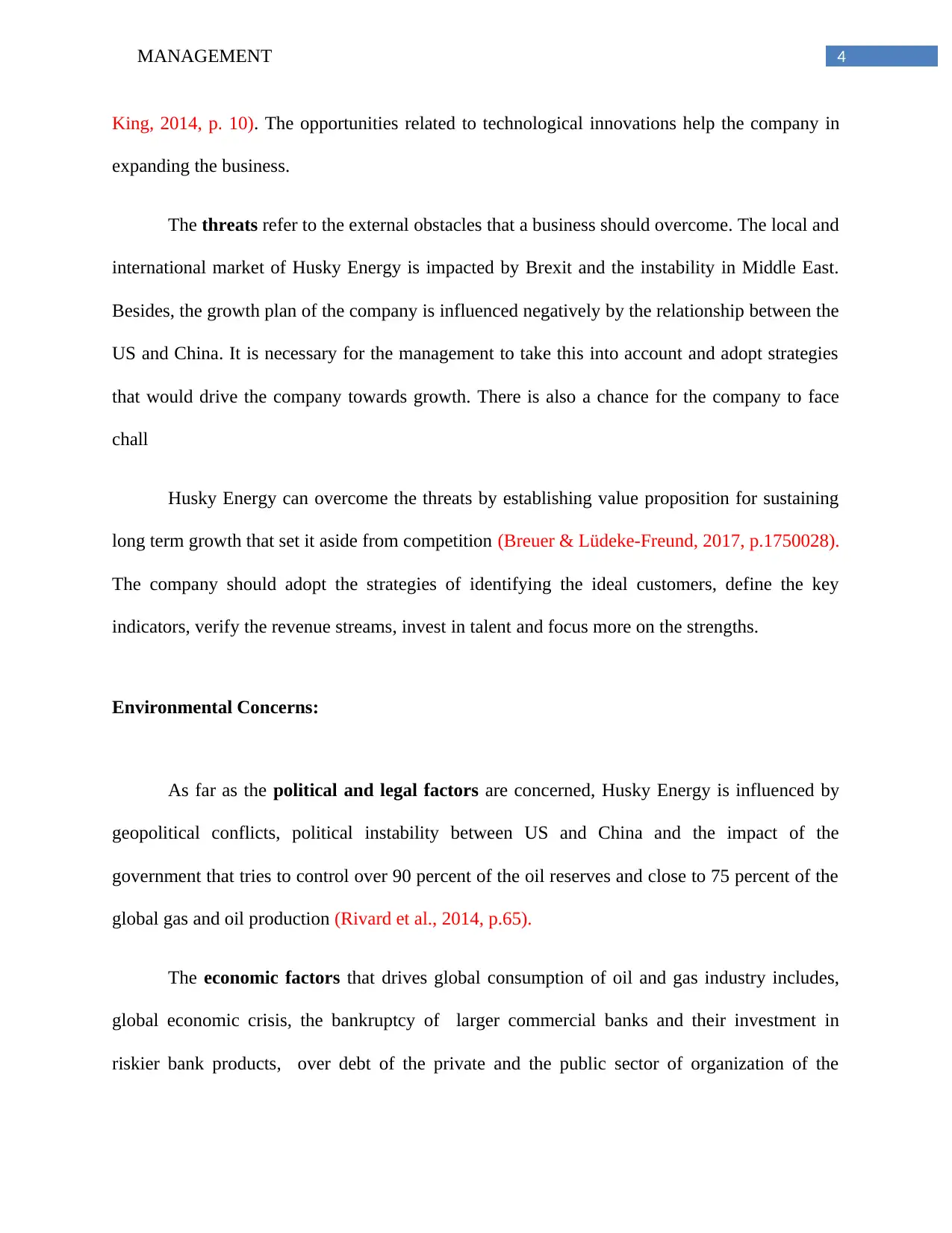
4MANAGEMENT
King, 2014, p. 10). The opportunities related to technological innovations help the company in
expanding the business.
The threats refer to the external obstacles that a business should overcome. The local and
international market of Husky Energy is impacted by Brexit and the instability in Middle East.
Besides, the growth plan of the company is influenced negatively by the relationship between the
US and China. It is necessary for the management to take this into account and adopt strategies
that would drive the company towards growth. There is also a chance for the company to face
chall
Husky Energy can overcome the threats by establishing value proposition for sustaining
long term growth that set it aside from competition (Breuer & Lüdeke-Freund, 2017, p.1750028).
The company should adopt the strategies of identifying the ideal customers, define the key
indicators, verify the revenue streams, invest in talent and focus more on the strengths.
Environmental Concerns:
As far as the political and legal factors are concerned, Husky Energy is influenced by
geopolitical conflicts, political instability between US and China and the impact of the
government that tries to control over 90 percent of the oil reserves and close to 75 percent of the
global gas and oil production (Rivard et al., 2014, p.65).
The economic factors that drives global consumption of oil and gas industry includes,
global economic crisis, the bankruptcy of larger commercial banks and their investment in
riskier bank products, over debt of the private and the public sector of organization of the
King, 2014, p. 10). The opportunities related to technological innovations help the company in
expanding the business.
The threats refer to the external obstacles that a business should overcome. The local and
international market of Husky Energy is impacted by Brexit and the instability in Middle East.
Besides, the growth plan of the company is influenced negatively by the relationship between the
US and China. It is necessary for the management to take this into account and adopt strategies
that would drive the company towards growth. There is also a chance for the company to face
chall
Husky Energy can overcome the threats by establishing value proposition for sustaining
long term growth that set it aside from competition (Breuer & Lüdeke-Freund, 2017, p.1750028).
The company should adopt the strategies of identifying the ideal customers, define the key
indicators, verify the revenue streams, invest in talent and focus more on the strengths.
Environmental Concerns:
As far as the political and legal factors are concerned, Husky Energy is influenced by
geopolitical conflicts, political instability between US and China and the impact of the
government that tries to control over 90 percent of the oil reserves and close to 75 percent of the
global gas and oil production (Rivard et al., 2014, p.65).
The economic factors that drives global consumption of oil and gas industry includes,
global economic crisis, the bankruptcy of larger commercial banks and their investment in
riskier bank products, over debt of the private and the public sector of organization of the
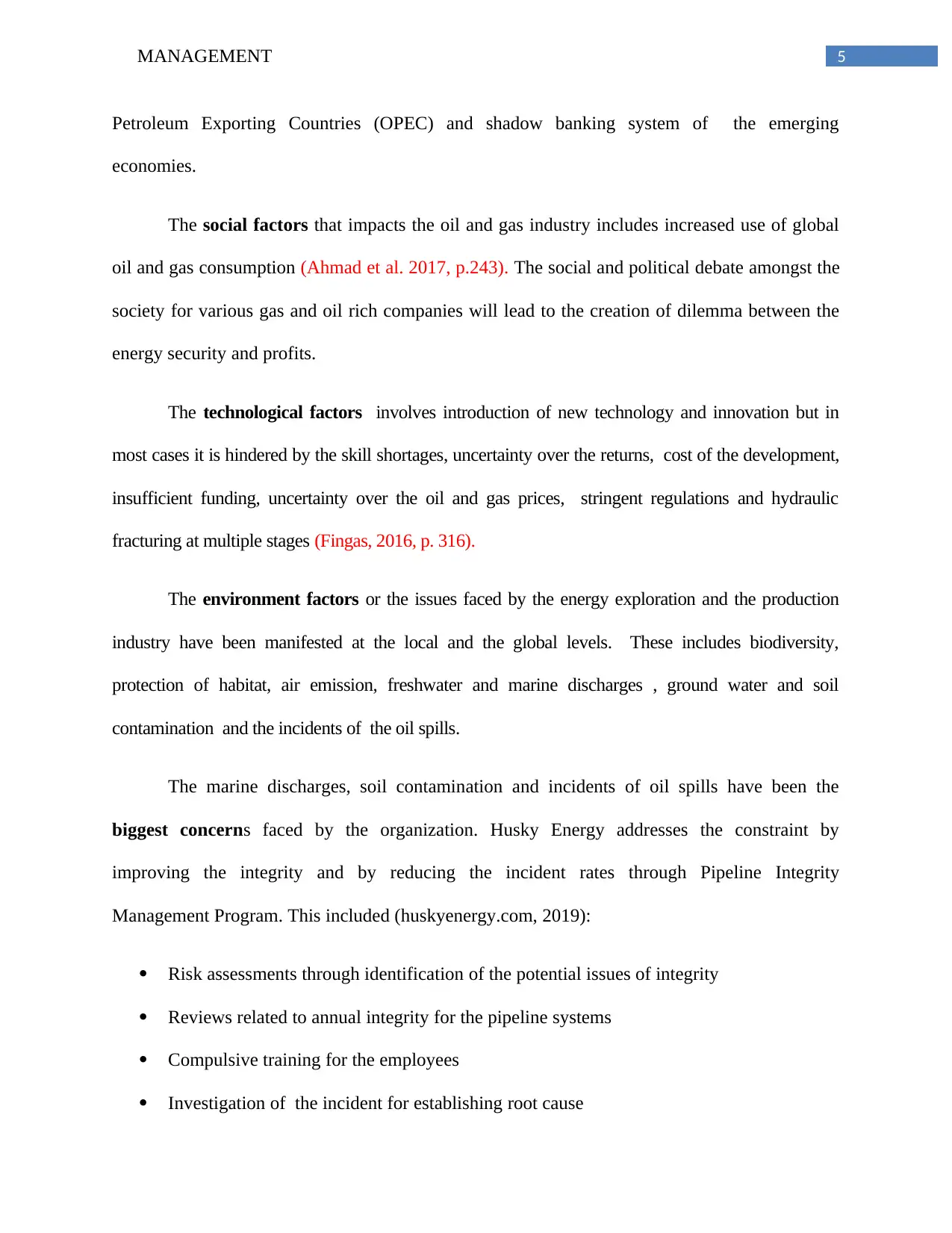
5MANAGEMENT
Petroleum Exporting Countries (OPEC) and shadow banking system of the emerging
economies.
The social factors that impacts the oil and gas industry includes increased use of global
oil and gas consumption (Ahmad et al. 2017, p.243). The social and political debate amongst the
society for various gas and oil rich companies will lead to the creation of dilemma between the
energy security and profits.
The technological factors involves introduction of new technology and innovation but in
most cases it is hindered by the skill shortages, uncertainty over the returns, cost of the development,
insufficient funding, uncertainty over the oil and gas prices, stringent regulations and hydraulic
fracturing at multiple stages (Fingas, 2016, p. 316).
The environment factors or the issues faced by the energy exploration and the production
industry have been manifested at the local and the global levels. These includes biodiversity,
protection of habitat, air emission, freshwater and marine discharges , ground water and soil
contamination and the incidents of the oil spills.
The marine discharges, soil contamination and incidents of oil spills have been the
biggest concerns faced by the organization. Husky Energy addresses the constraint by
improving the integrity and by reducing the incident rates through Pipeline Integrity
Management Program. This included (huskyenergy.com, 2019):
Risk assessments through identification of the potential issues of integrity
Reviews related to annual integrity for the pipeline systems
Compulsive training for the employees
Investigation of the incident for establishing root cause
Petroleum Exporting Countries (OPEC) and shadow banking system of the emerging
economies.
The social factors that impacts the oil and gas industry includes increased use of global
oil and gas consumption (Ahmad et al. 2017, p.243). The social and political debate amongst the
society for various gas and oil rich companies will lead to the creation of dilemma between the
energy security and profits.
The technological factors involves introduction of new technology and innovation but in
most cases it is hindered by the skill shortages, uncertainty over the returns, cost of the development,
insufficient funding, uncertainty over the oil and gas prices, stringent regulations and hydraulic
fracturing at multiple stages (Fingas, 2016, p. 316).
The environment factors or the issues faced by the energy exploration and the production
industry have been manifested at the local and the global levels. These includes biodiversity,
protection of habitat, air emission, freshwater and marine discharges , ground water and soil
contamination and the incidents of the oil spills.
The marine discharges, soil contamination and incidents of oil spills have been the
biggest concerns faced by the organization. Husky Energy addresses the constraint by
improving the integrity and by reducing the incident rates through Pipeline Integrity
Management Program. This included (huskyenergy.com, 2019):
Risk assessments through identification of the potential issues of integrity
Reviews related to annual integrity for the pipeline systems
Compulsive training for the employees
Investigation of the incident for establishing root cause
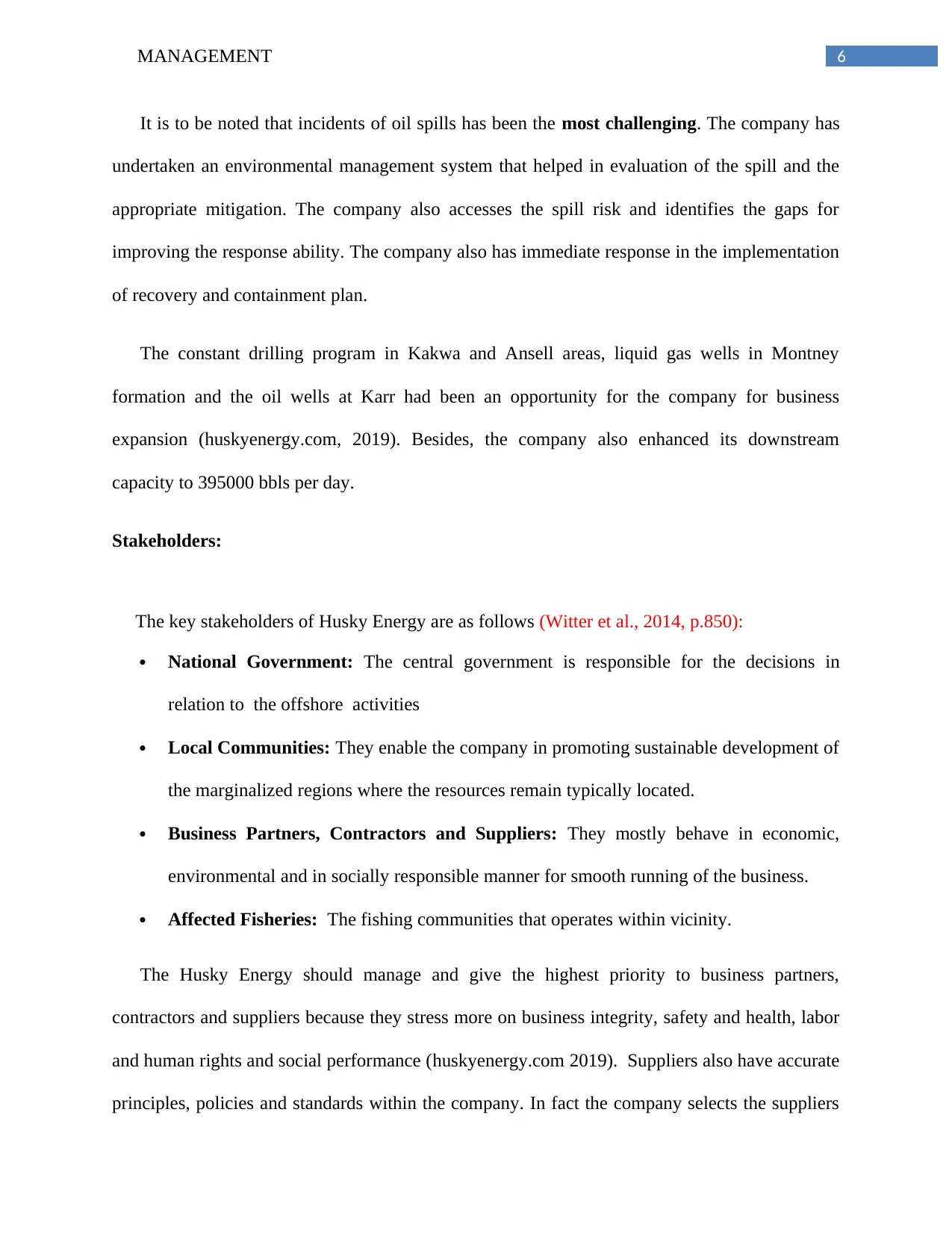
6MANAGEMENT
It is to be noted that incidents of oil spills has been the most challenging. The company has
undertaken an environmental management system that helped in evaluation of the spill and the
appropriate mitigation. The company also accesses the spill risk and identifies the gaps for
improving the response ability. The company also has immediate response in the implementation
of recovery and containment plan.
The constant drilling program in Kakwa and Ansell areas, liquid gas wells in Montney
formation and the oil wells at Karr had been an opportunity for the company for business
expansion (huskyenergy.com, 2019). Besides, the company also enhanced its downstream
capacity to 395000 bbls per day.
Stakeholders:
The key stakeholders of Husky Energy are as follows (Witter et al., 2014, p.850):
National Government: The central government is responsible for the decisions in
relation to the offshore activities
Local Communities: They enable the company in promoting sustainable development of
the marginalized regions where the resources remain typically located.
Business Partners, Contractors and Suppliers: They mostly behave in economic,
environmental and in socially responsible manner for smooth running of the business.
Affected Fisheries: The fishing communities that operates within vicinity.
The Husky Energy should manage and give the highest priority to business partners,
contractors and suppliers because they stress more on business integrity, safety and health, labor
and human rights and social performance (huskyenergy.com 2019). Suppliers also have accurate
principles, policies and standards within the company. In fact the company selects the suppliers
It is to be noted that incidents of oil spills has been the most challenging. The company has
undertaken an environmental management system that helped in evaluation of the spill and the
appropriate mitigation. The company also accesses the spill risk and identifies the gaps for
improving the response ability. The company also has immediate response in the implementation
of recovery and containment plan.
The constant drilling program in Kakwa and Ansell areas, liquid gas wells in Montney
formation and the oil wells at Karr had been an opportunity for the company for business
expansion (huskyenergy.com, 2019). Besides, the company also enhanced its downstream
capacity to 395000 bbls per day.
Stakeholders:
The key stakeholders of Husky Energy are as follows (Witter et al., 2014, p.850):
National Government: The central government is responsible for the decisions in
relation to the offshore activities
Local Communities: They enable the company in promoting sustainable development of
the marginalized regions where the resources remain typically located.
Business Partners, Contractors and Suppliers: They mostly behave in economic,
environmental and in socially responsible manner for smooth running of the business.
Affected Fisheries: The fishing communities that operates within vicinity.
The Husky Energy should manage and give the highest priority to business partners,
contractors and suppliers because they stress more on business integrity, safety and health, labor
and human rights and social performance (huskyenergy.com 2019). Suppliers also have accurate
principles, policies and standards within the company. In fact the company selects the suppliers
Paraphrase This Document
Need a fresh take? Get an instant paraphrase of this document with our AI Paraphraser
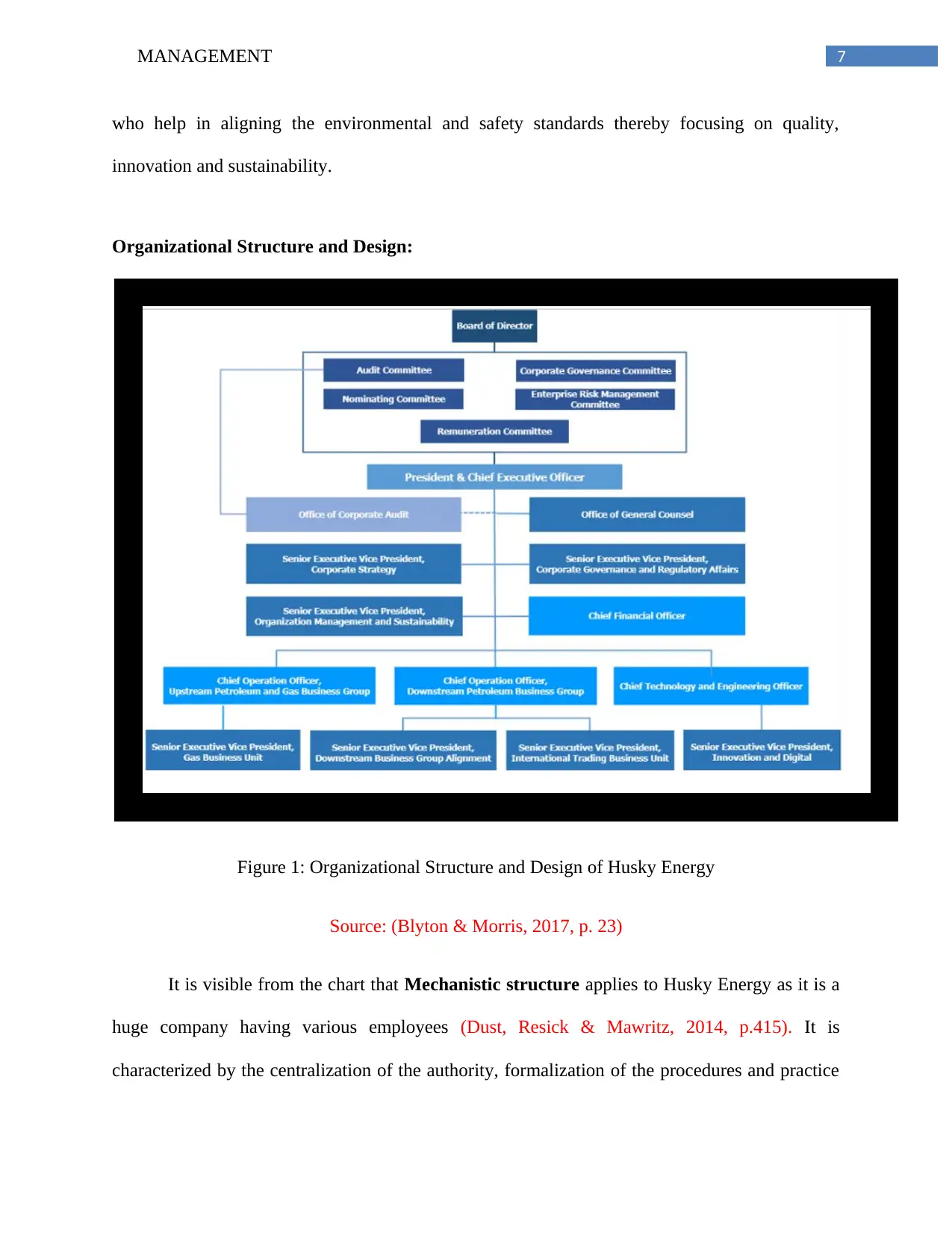
7MANAGEMENT
who help in aligning the environmental and safety standards thereby focusing on quality,
innovation and sustainability.
Organizational Structure and Design:
Figure 1: Organizational Structure and Design of Husky Energy
Source: (Blyton & Morris, 2017, p. 23)
It is visible from the chart that Mechanistic structure applies to Husky Energy as it is a
huge company having various employees (Dust, Resick & Mawritz, 2014, p.415). It is
characterized by the centralization of the authority, formalization of the procedures and practice
who help in aligning the environmental and safety standards thereby focusing on quality,
innovation and sustainability.
Organizational Structure and Design:
Figure 1: Organizational Structure and Design of Husky Energy
Source: (Blyton & Morris, 2017, p. 23)
It is visible from the chart that Mechanistic structure applies to Husky Energy as it is a
huge company having various employees (Dust, Resick & Mawritz, 2014, p.415). It is
characterized by the centralization of the authority, formalization of the procedures and practice
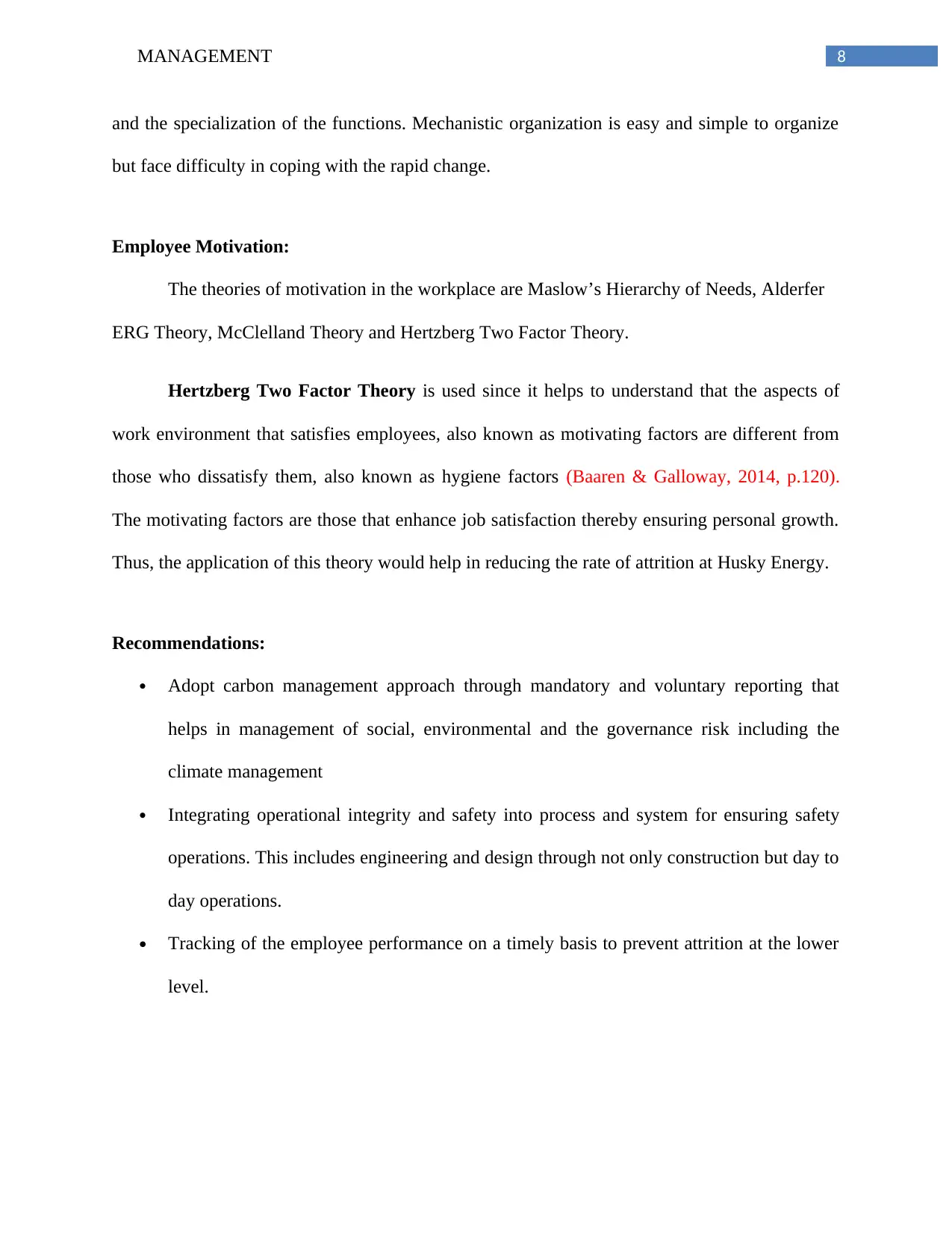
8MANAGEMENT
and the specialization of the functions. Mechanistic organization is easy and simple to organize
but face difficulty in coping with the rapid change.
Employee Motivation:
The theories of motivation in the workplace are Maslow’s Hierarchy of Needs, Alderfer
ERG Theory, McClelland Theory and Hertzberg Two Factor Theory.
Hertzberg Two Factor Theory is used since it helps to understand that the aspects of
work environment that satisfies employees, also known as motivating factors are different from
those who dissatisfy them, also known as hygiene factors (Baaren & Galloway, 2014, p.120).
The motivating factors are those that enhance job satisfaction thereby ensuring personal growth.
Thus, the application of this theory would help in reducing the rate of attrition at Husky Energy.
Recommendations:
Adopt carbon management approach through mandatory and voluntary reporting that
helps in management of social, environmental and the governance risk including the
climate management
Integrating operational integrity and safety into process and system for ensuring safety
operations. This includes engineering and design through not only construction but day to
day operations.
Tracking of the employee performance on a timely basis to prevent attrition at the lower
level.
and the specialization of the functions. Mechanistic organization is easy and simple to organize
but face difficulty in coping with the rapid change.
Employee Motivation:
The theories of motivation in the workplace are Maslow’s Hierarchy of Needs, Alderfer
ERG Theory, McClelland Theory and Hertzberg Two Factor Theory.
Hertzberg Two Factor Theory is used since it helps to understand that the aspects of
work environment that satisfies employees, also known as motivating factors are different from
those who dissatisfy them, also known as hygiene factors (Baaren & Galloway, 2014, p.120).
The motivating factors are those that enhance job satisfaction thereby ensuring personal growth.
Thus, the application of this theory would help in reducing the rate of attrition at Husky Energy.
Recommendations:
Adopt carbon management approach through mandatory and voluntary reporting that
helps in management of social, environmental and the governance risk including the
climate management
Integrating operational integrity and safety into process and system for ensuring safety
operations. This includes engineering and design through not only construction but day to
day operations.
Tracking of the employee performance on a timely basis to prevent attrition at the lower
level.
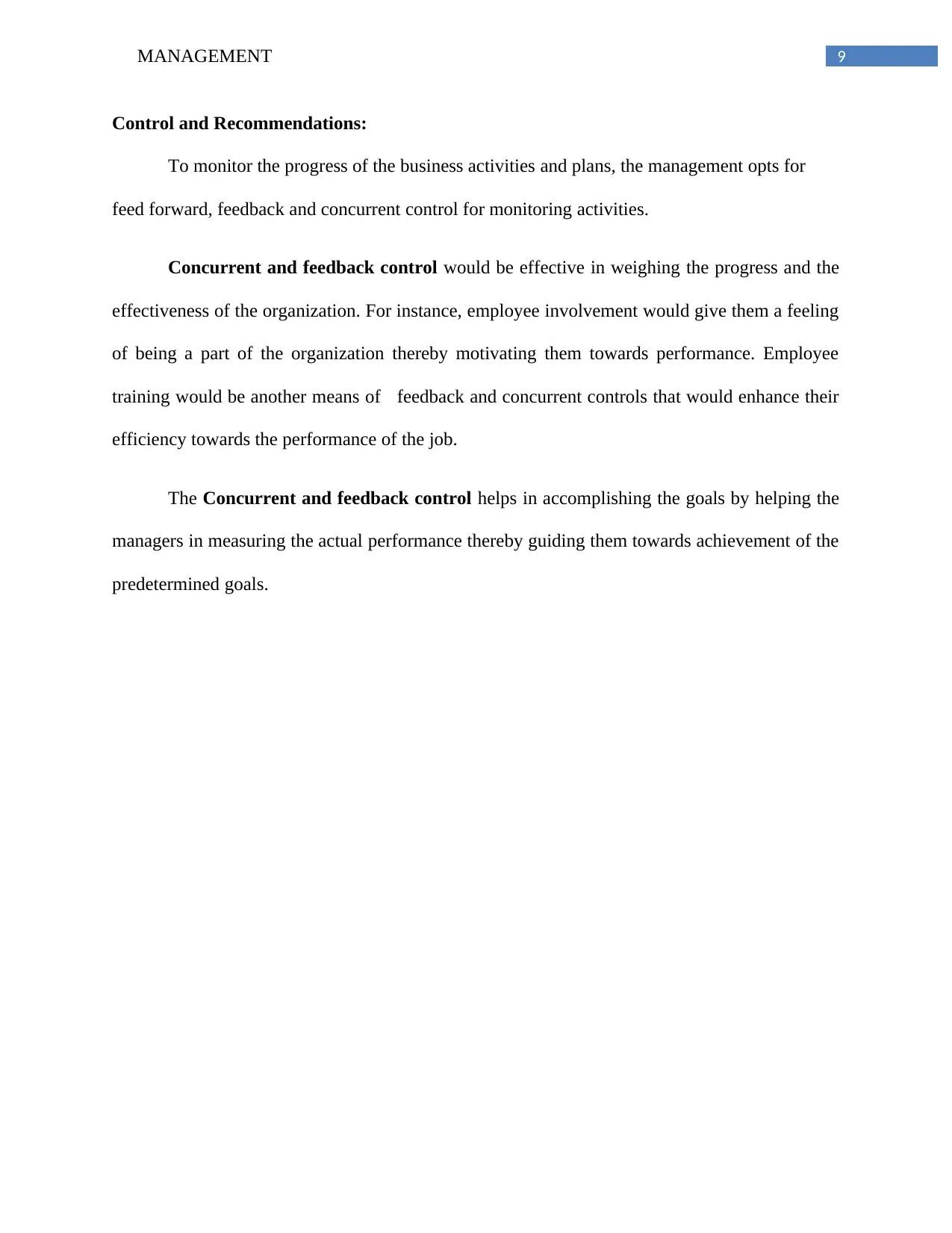
9MANAGEMENT
Control and Recommendations:
To monitor the progress of the business activities and plans, the management opts for
feed forward, feedback and concurrent control for monitoring activities.
Concurrent and feedback control would be effective in weighing the progress and the
effectiveness of the organization. For instance, employee involvement would give them a feeling
of being a part of the organization thereby motivating them towards performance. Employee
training would be another means of feedback and concurrent controls that would enhance their
efficiency towards the performance of the job.
The Concurrent and feedback control helps in accomplishing the goals by helping the
managers in measuring the actual performance thereby guiding them towards achievement of the
predetermined goals.
Control and Recommendations:
To monitor the progress of the business activities and plans, the management opts for
feed forward, feedback and concurrent control for monitoring activities.
Concurrent and feedback control would be effective in weighing the progress and the
effectiveness of the organization. For instance, employee involvement would give them a feeling
of being a part of the organization thereby motivating them towards performance. Employee
training would be another means of feedback and concurrent controls that would enhance their
efficiency towards the performance of the job.
The Concurrent and feedback control helps in accomplishing the goals by helping the
managers in measuring the actual performance thereby guiding them towards achievement of the
predetermined goals.
Secure Best Marks with AI Grader
Need help grading? Try our AI Grader for instant feedback on your assignments.
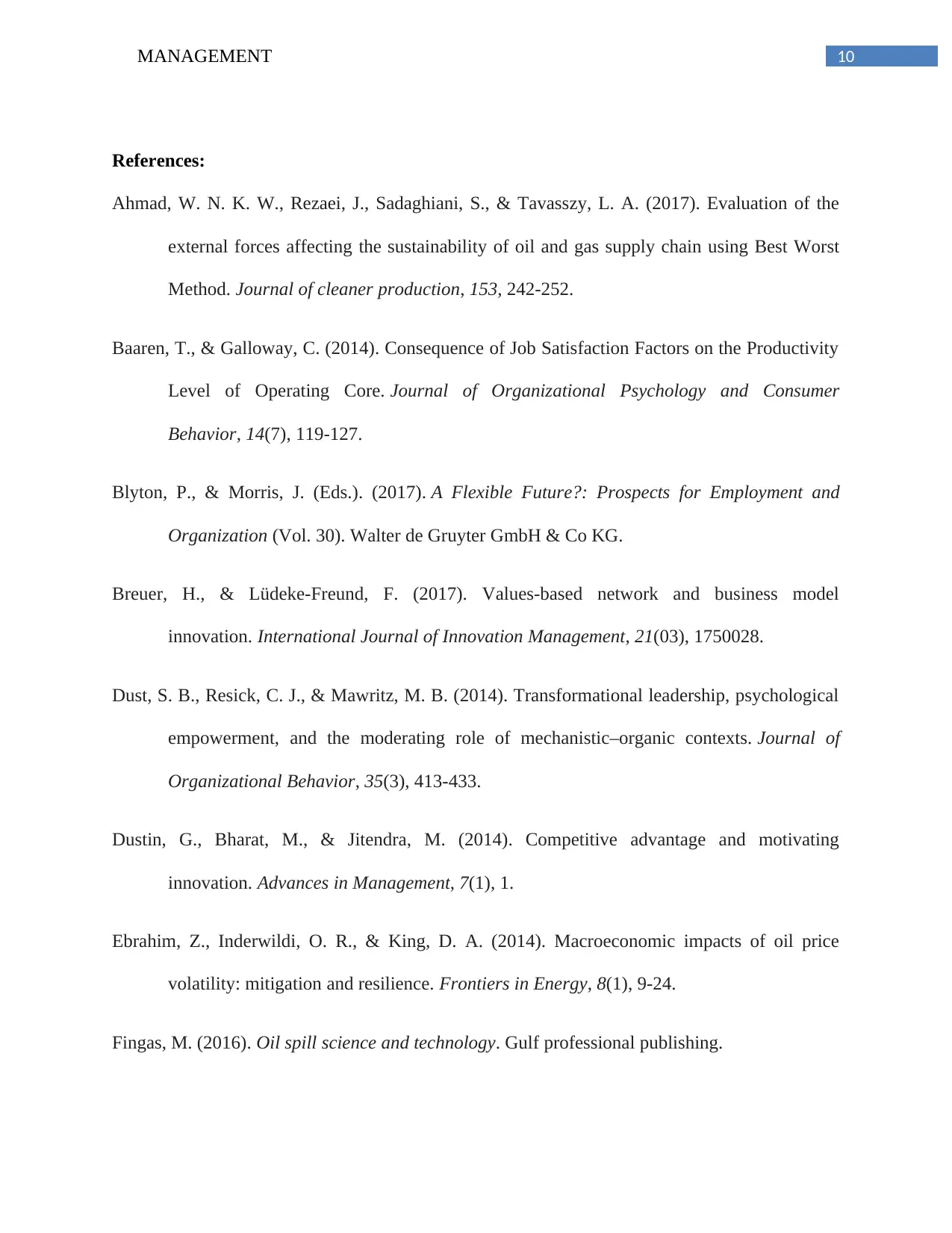
10MANAGEMENT
References:
Ahmad, W. N. K. W., Rezaei, J., Sadaghiani, S., & Tavasszy, L. A. (2017). Evaluation of the
external forces affecting the sustainability of oil and gas supply chain using Best Worst
Method. Journal of cleaner production, 153, 242-252.
Baaren, T., & Galloway, C. (2014). Consequence of Job Satisfaction Factors on the Productivity
Level of Operating Core. Journal of Organizational Psychology and Consumer
Behavior, 14(7), 119-127.
Blyton, P., & Morris, J. (Eds.). (2017). A Flexible Future?: Prospects for Employment and
Organization (Vol. 30). Walter de Gruyter GmbH & Co KG.
Breuer, H., & Lüdeke-Freund, F. (2017). Values-based network and business model
innovation. International Journal of Innovation Management, 21(03), 1750028.
Dust, S. B., Resick, C. J., & Mawritz, M. B. (2014). Transformational leadership, psychological
empowerment, and the moderating role of mechanistic–organic contexts. Journal of
Organizational Behavior, 35(3), 413-433.
Dustin, G., Bharat, M., & Jitendra, M. (2014). Competitive advantage and motivating
innovation. Advances in Management, 7(1), 1.
Ebrahim, Z., Inderwildi, O. R., & King, D. A. (2014). Macroeconomic impacts of oil price
volatility: mitigation and resilience. Frontiers in Energy, 8(1), 9-24.
Fingas, M. (2016). Oil spill science and technology. Gulf professional publishing.
References:
Ahmad, W. N. K. W., Rezaei, J., Sadaghiani, S., & Tavasszy, L. A. (2017). Evaluation of the
external forces affecting the sustainability of oil and gas supply chain using Best Worst
Method. Journal of cleaner production, 153, 242-252.
Baaren, T., & Galloway, C. (2014). Consequence of Job Satisfaction Factors on the Productivity
Level of Operating Core. Journal of Organizational Psychology and Consumer
Behavior, 14(7), 119-127.
Blyton, P., & Morris, J. (Eds.). (2017). A Flexible Future?: Prospects for Employment and
Organization (Vol. 30). Walter de Gruyter GmbH & Co KG.
Breuer, H., & Lüdeke-Freund, F. (2017). Values-based network and business model
innovation. International Journal of Innovation Management, 21(03), 1750028.
Dust, S. B., Resick, C. J., & Mawritz, M. B. (2014). Transformational leadership, psychological
empowerment, and the moderating role of mechanistic–organic contexts. Journal of
Organizational Behavior, 35(3), 413-433.
Dustin, G., Bharat, M., & Jitendra, M. (2014). Competitive advantage and motivating
innovation. Advances in Management, 7(1), 1.
Ebrahim, Z., Inderwildi, O. R., & King, D. A. (2014). Macroeconomic impacts of oil price
volatility: mitigation and resilience. Frontiers in Energy, 8(1), 9-24.
Fingas, M. (2016). Oil spill science and technology. Gulf professional publishing.
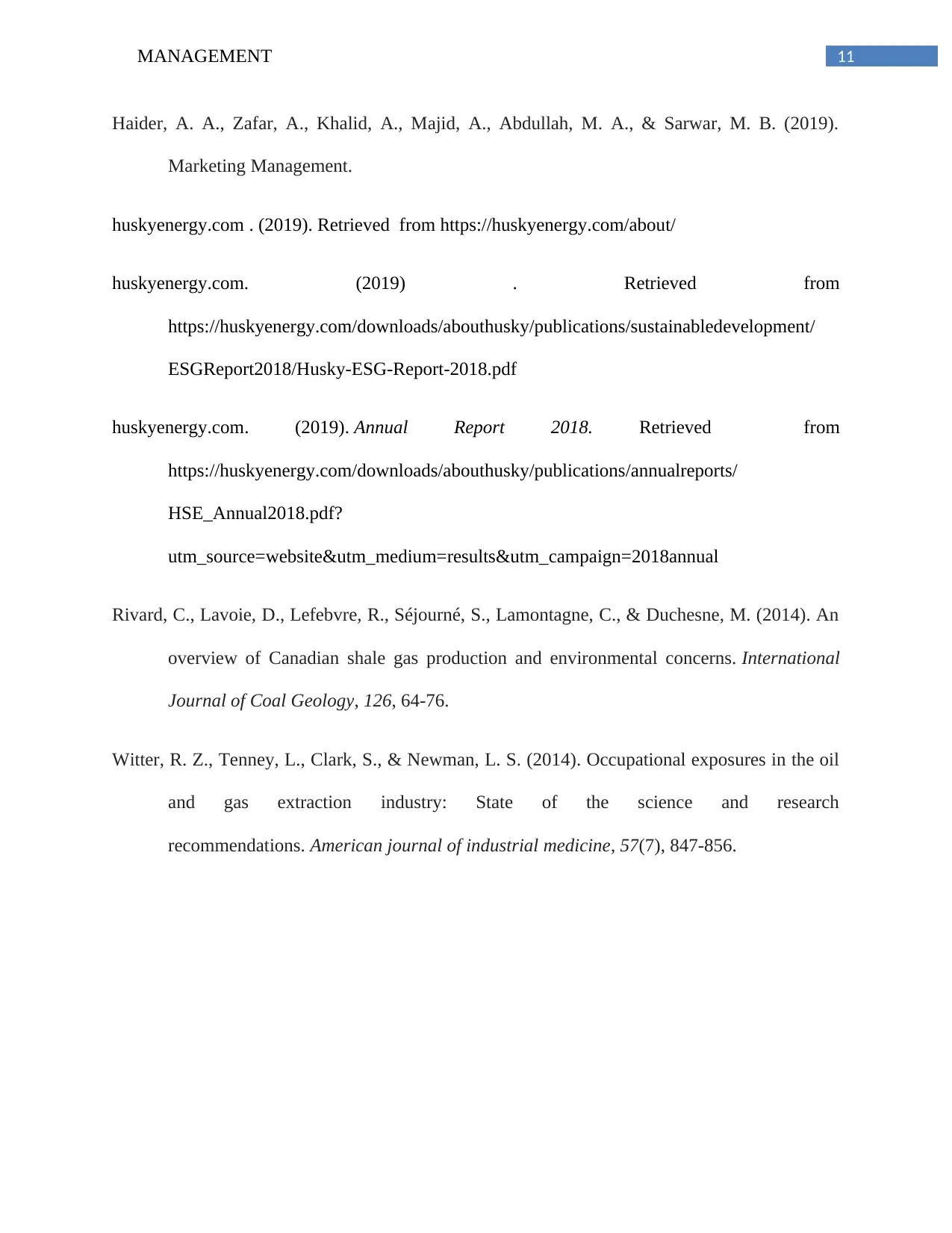
11MANAGEMENT
Haider, A. A., Zafar, A., Khalid, A., Majid, A., Abdullah, M. A., & Sarwar, M. B. (2019).
Marketing Management.
huskyenergy.com . (2019). Retrieved from https://huskyenergy.com/about/
huskyenergy.com. (2019) . Retrieved from
https://huskyenergy.com/downloads/abouthusky/publications/sustainabledevelopment/
ESGReport2018/Husky-ESG-Report-2018.pdf
huskyenergy.com. (2019). Annual Report 2018. Retrieved from
https://huskyenergy.com/downloads/abouthusky/publications/annualreports/
HSE_Annual2018.pdf?
utm_source=website&utm_medium=results&utm_campaign=2018annual
Rivard, C., Lavoie, D., Lefebvre, R., Séjourné, S., Lamontagne, C., & Duchesne, M. (2014). An
overview of Canadian shale gas production and environmental concerns. International
Journal of Coal Geology, 126, 64-76.
Witter, R. Z., Tenney, L., Clark, S., & Newman, L. S. (2014). Occupational exposures in the oil
and gas extraction industry: State of the science and research
recommendations. American journal of industrial medicine, 57(7), 847-856.
Haider, A. A., Zafar, A., Khalid, A., Majid, A., Abdullah, M. A., & Sarwar, M. B. (2019).
Marketing Management.
huskyenergy.com . (2019). Retrieved from https://huskyenergy.com/about/
huskyenergy.com. (2019) . Retrieved from
https://huskyenergy.com/downloads/abouthusky/publications/sustainabledevelopment/
ESGReport2018/Husky-ESG-Report-2018.pdf
huskyenergy.com. (2019). Annual Report 2018. Retrieved from
https://huskyenergy.com/downloads/abouthusky/publications/annualreports/
HSE_Annual2018.pdf?
utm_source=website&utm_medium=results&utm_campaign=2018annual
Rivard, C., Lavoie, D., Lefebvre, R., Séjourné, S., Lamontagne, C., & Duchesne, M. (2014). An
overview of Canadian shale gas production and environmental concerns. International
Journal of Coal Geology, 126, 64-76.
Witter, R. Z., Tenney, L., Clark, S., & Newman, L. S. (2014). Occupational exposures in the oil
and gas extraction industry: State of the science and research
recommendations. American journal of industrial medicine, 57(7), 847-856.
1 out of 12
Related Documents
Your All-in-One AI-Powered Toolkit for Academic Success.
+13062052269
info@desklib.com
Available 24*7 on WhatsApp / Email
![[object Object]](/_next/static/media/star-bottom.7253800d.svg)
Unlock your academic potential
© 2024 | Zucol Services PVT LTD | All rights reserved.





